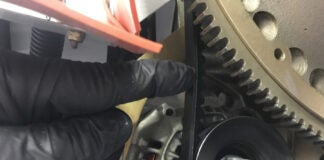 At AirVenture 2007, I took the challenge of sampling the builder workshops—specifically sheet metal, composites and fabric—as a clean-sheet newbie. I wanted to see if I could pick up the basic skills necessary for building, and how the instructors and Technical Counselors would do with a rookie. Thanks to their patience, expertise and clarity in explaining the basics, I was indeed able to pick up the basics. (Look for the full report in the June issue of KITPLANES magazine.)
At AirVenture 2007, I took the challenge of sampling the builder workshops—specifically sheet metal, composites and fabric—as a clean-sheet newbie. I wanted to see if I could pick up the basic skills necessary for building, and how the instructors and Technical Counselors would do with a rookie. Thanks to their patience, expertise and clarity in explaining the basics, I was indeed able to pick up the basics. (Look for the full report in the June issue of KITPLANES magazine.) When the aircraft is completed (and dubbed Angel 1), it will be donated to a missionary organization. Several tool companies, including Avery, provided some metal-working tools, but the construction is being undertaken by the workshop volunteers and the folks who come to learn basic metal skills—no company participation. The plan is to build as much as possible during the show, and then complete it at the owner’s home airport in Mississippi.
When the aircraft is completed (and dubbed Angel 1), it will be donated to a missionary organization. Several tool companies, including Avery, provided some metal-working tools, but the construction is being undertaken by the workshop volunteers and the folks who come to learn basic metal skills—no company participation. The plan is to build as much as possible during the show, and then complete it at the owner’s home airport in Mississippi.The 701 was well underway by the time I wandered into the air-conditioned workshop this morning, with a good portion of the fuselage having been riveted, and with a wing and a horizontal stabilizer laid out on the other tables. Under Hoak’s supervision, the horizontal stab has been reworked several times until the measurements were as called out in Zenith’s plans—a copy of which was prominent at each work station.
 My participation consisted of pulling a long line of blind rivets with a pneumatic rivet puller, with the assistance of a couple of volunteers who made sure the rivets were square to the fuselage skin, and that the interior sheet metal didn’t gap. After we pulled the majority of the rivets, out came the Clecoes and in went the rest of the rivets.
My participation consisted of pulling a long line of blind rivets with a pneumatic rivet puller, with the assistance of a couple of volunteers who made sure the rivets were square to the fuselage skin, and that the interior sheet metal didn’t gap. After we pulled the majority of the rivets, out came the Clecoes and in went the rest of the rivets.




